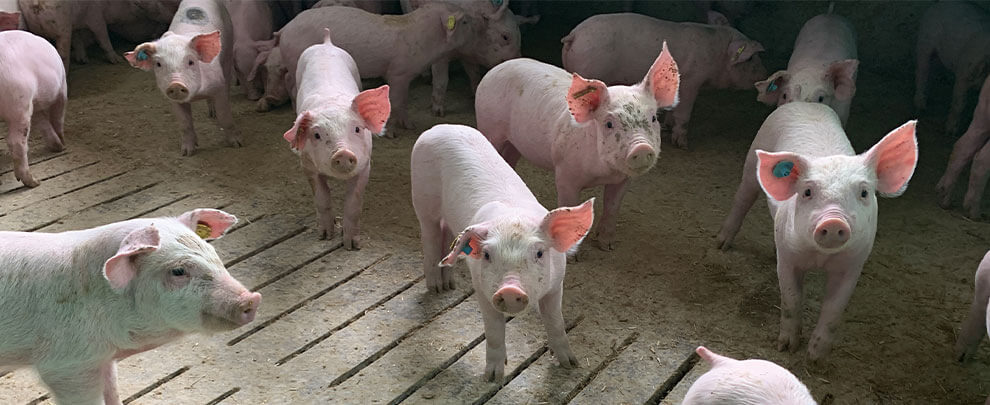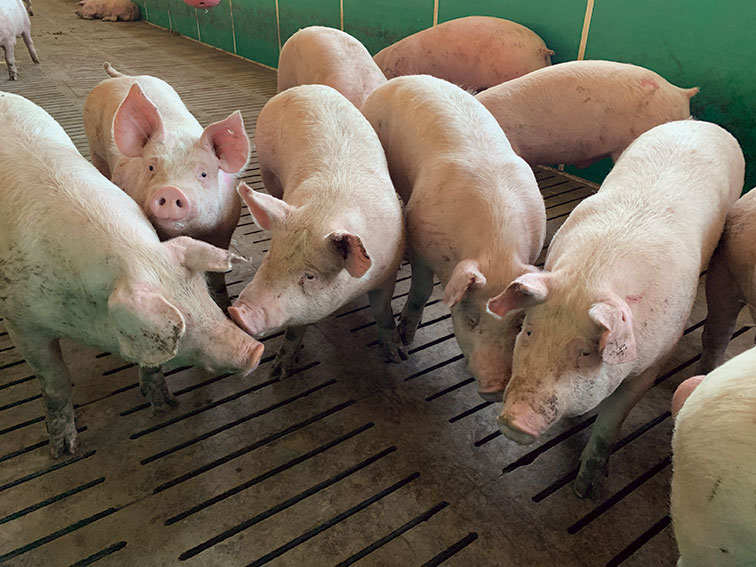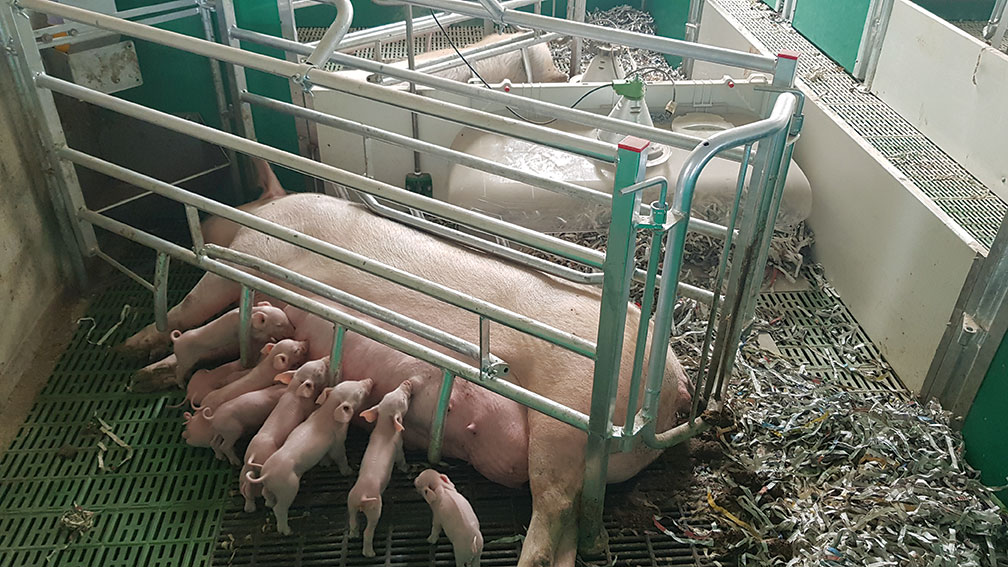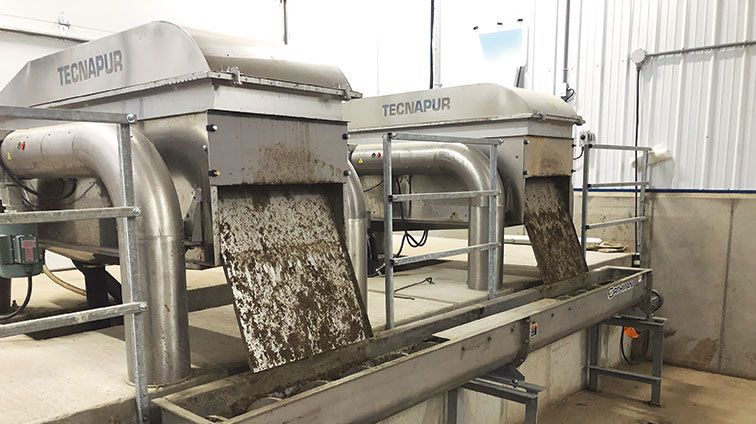Blog
Blog

Analysis of the Spanish pig sector in 2022
17 of March of 22 - News
In recent years, pigs have become one of the key sectors for the economy of our country, positioning itself as the most relevant sector for Spanish livestock with more than 40% of the Final Livestock Production and around 16% of the Final Agricultural Production, only surpassed by fruits and vegetables. Its activity accounts for 1.4% of the national GDP and 14% of the Gross Industrial Domestic Product. To see what have been the factors that have contributed to achieving these figures, we have spoken with different professionals in our sector to offer a wider perspective of where we are and where we are going.
The successful figures that the pork sector has registered in recent times are the result of a business model, a worldwide reference, based on important pillars such as innovation and professionalisation. This was stated by Miguel Ángel Higuera, director of the National Association of Pig Producers (ANPROGAPOR): "We are one of the sectors that have invested the most in innovation and technology at all levels (food, genetics, management, health, facilities, etc.), which has spectacularly improved our sector. These pillars are making us increasingly competitive and efficient."
This competitiveness is what has allowed us to advance and open new markets abroad. According to Albert Vidal, director of Animal Production of the Vall Companys group, the pork sector exports more than 8,000 million euros, which places us as one of the main exporters at the European and worldwide level. "With a very positive trade balance, Spain consolidated itself as the second-largest pork exporter in the EU, only behind Germany, dramatically increasing exports to other countries, especially to China and other countries in Southeast Asia," he explains, adding: "Achieving a position of international leadership has forced us not only to be efficient but also to be better in biosecurity, animal welfare, sustainability, circular economy, etc. All without ceasing to reflect, self-criticise and try to continue progressing". However, it must be remembered that before reaching this position, the pork sector worked hard during the 90s to end diseases such as classical swine fever, and to open up to export. As Rossend Saltiveri, responsible for the pork sector at “Unió de Pagesos” explains, "the entire meat industry has been interweaving a marketing path that has created a greater demand for pigs that year after year we have been serving. Now, with China's recovery from African swine fever (ASF), it is essential to work to place the meat that China imported in other countries."

Spain is the world’s third largest producer of pork. Photo: Rotecna.
This last issue, the recovery of China, is one of the issues that most worries the sector since the Asian giant is returning to the productive levels of the years before the entry of ASF into the country, making it necessary to adjust exports. In this sense, Higuera assures that "the strength of the pork sector is that the volume of meat produced and its variety of cuts makes us open to export many types of products to markets such as Japan, Korea or Thailand". However, the European Union is being the one who assumes the volumes that previously went to China. Thus, it is returning to the starting point in terms of external trade, where the EU is the main market.
Everything mentioned so far has contributed to the Spanish pig being one of the main performers in the EU and the world, and to be a reference. On this subject, Vicenç Brieba, director of animal feed at Bon Área, believes that, although much remains to be done, cost competitiveness compared to the rest of European countries has been key to the success of the sector. "This competitiveness is mainly due to the integration system, which has allowed small farmers to make investments in their farms without taking market risks, which are assumed by the integrating companies. We must not forget that Spanish slaughterhouses have been modernised and have achieved markets with a large number of customers in many countries, attaining great international prestige for Spanish pork, "says Brieba. Regarding this issue, Alba García, manager of the National Cluster of Pork Producers (I+Porc), adds: "We are at a time when real investment efforts are being made for the future, especially in those issues that guarantee competitiveness and sustainability, and I refer to aspects such as biosecurity, which is so important in animal health, in aspects related to the environment, more and better technologies that facilitate environmental sustainability, and animal welfare aspects".
In addition to what has been said so far, we must bear in mind something that Óscar Toledano, commercial director of Rotecna, comments, and that is that "the economic and social importance of the sector is a fact, especially in areas with serious problems of depopulation, where it plays a vital role in generating quality jobs that help young talent and promote female employment".
Costs
The pork sector closed in 2021 in the red, a situation that contrasted sharply with that experienced at the beginning of the year when there was a high demand for pork from China, and with it, the prices rose. As Vidal explains, "we started 2022 with a live price stagnant at historic lows and it seems that now it is beginning to grow to the extent that it did in previous years." Given this panorama, it is essential to monitor cost control closely, because "since July 2020 the raw materials sector has been experiencing an unprecedented price increase and this affects the competitiveness of the entire meat and livestock value chain," Vidal warns.
To better understand the situation, Brieba provides a point of view based on historical criteria: "History tells us that the spikes in commodity prices are periodic. But it is true that, when they return to 'normal', they are higher than in the previous normal. We have also been able to see that the descents are usually quite abrupt."
In 2022 there have not been many changes compared to the end of 2021, and farmers live in a significant shortage situation. "The costs are high, both in energy and food and, therefore, the results of the producers are negative," says Saltiveri. Higuera expects an improvement on this issue, although he expresses his concern about the production costs of raw materials: "The prices of raw materials are rising strongly. Political conflicts do not help contain these prices and contribute to their volatility. In addition, there is a high degree of speculation, which translates into an increase in the feed price."
"Political conflicts do not help contain these prices and contribute to their volatility."
To deal with the disproportion between the cost of feed and the animals' sale price, ANPROGAPOR works with the Ministry of Agriculture and Livestock and with the autonomous communities in actions such as the development of a structural plan to improve the efficiency of the supply, both of imported raw materials and national ones, and thus compensate for price volatility. On the other hand, it is also necessary to readjust supply with demand at the European Union level. In this sense, Higuera assures that "we must retake those markets that we left in second place due to the China effect, such as the EU, and make a campaign of positioning and promotion of European products in those countries that are high pork consumers, to motivate export to those markets. In this way, with the growing demand we are having in the EU and the reconquest of those third countries, we could regain balance."
Animal welfare and health
The EU has one of the most demanding legislations in the world in terms of animal welfare, which has led the Spanish pork sector to achieve one of the highest levels of productivity in the world. As Vidal explains, "the existing legislation attempts to satisfy the five freedoms of animals: the comfort of the animal in the global ecosystem of the farm and its pen; the pleasure of the animal to access and choose its food and also to have at its disposal enrichment material; health; trust, with positive interactions with humans and other pigs without fear or stress; and the permissibility of innate behaviours of free interest or expression of the animal", and adds: "The main meat-livestock companies have very high animal welfare and food safety certifications". All this has contributed to being able to improve on farms and produce a better quality product more efficiently.

The EU has one of the most demanding legislation in the world in terms of animal welfare. Photo: Rotecna.
However, Brieba points out: "Perhaps there are factors that could be considered ineffective and the result of practical ignorance of breeding systems." In this sense, professionals demand that all legislation be applied with full knowledge and information since these laws affect farmers in terms of investments. For this reason, Saltiveri demands that each of the issues that are legislated be carefully studied and that it be done with the maximum information and transparency so as not to make erroneous investments. "The investments we are forced to make can suffocate some farmers and, therefore, reduce production, increase costs and encourage the entry of meat from other countries that produce more cheaply," he warns.
One of the issues that is currently under study is the new legislation that will minimise the time that animals are inside a cage. "Many farmers already limit their use to short periods, when necessary, to preserve the welfare of newborn piglets, achieving resulting products similar to those of other systems," says Toledano.
Environment
Since 2022, Spain has applied even more restrictive regulations regarding the emission of polluting gases and the application of slurry, to achieve maximum efficiency, have minimum nitrogen losses and achieve the maximum use of nutrients for slurry.
About the criticism received in recent times, it should be clarified that, according to the Spanish emissions system, those derived from pork production represent only 2% of the country's total GHG emissions, a fact that is not very relevant if one takes into account that Spain is the third-largest producer in the world, and that, as mentioned above, the activity of the pork sector accounts for 1.4% of the national GDP and 14% of the Gross Industrial Domestic Product. In addition, as Toledano explains, "we have made significant progress in the total reduction in emissions per kilogramme of meat produced, including those of atmospheric pollutants such as ammonia, as we have the means to continue doing so and we continue working on the development of new techniques to go even further."
Some of these techniques are BAT, which Saltiveri tells us about. "On the farm nowadays, we apply the available technical improvements (BAT) through ways such as feeding, offering the amount of protein that the pig needs in each of the growth phases, in housing, or the storage," he explains, adding: "The pork sector intends to go towards total or partial coverage of rafts to prevent emissions. As for fan application, it is already totally discarded here, and it is applied directly on the ground, which allows us to reach a reduction of 30 to 60% in terms of emissions". Thus, García assures that "we are sure that we are on the right track in terms of environment and slurry management."
We must also bear in mind that any co-product from droppings can be valued and returned to the agricultural cycle providing usefulness: valorising them as fertiliser reduces chemical synthesis and extractive origin fertiliser dependence, and their use improves soil structure. In this sense, Vidal recommends keeping in mind two relevant aspects: "The need to always use it per environmental parameters and continue working towards feed that allows droppings with less nitrogen". Nor should we forget that having a solid-liquid separator, in addition to giving a good image in terms of droppings management, will allow an optimal liquid fraction to pass it through fertigation, and have a solid fraction more easily transportable to those lands that need it, and can also serve as a raw material for other treatments such as composting or biogas.

Pig emissions represent only 2% of the country's total GHG. Photo: Rotecna.
ASF threat
In 2022, the situation regarding ASF has become highly worrying due to the proximity of the disease and its entry into Italy. As Higuera assures, "the concern of seeing how this disease is developing and the difficulties that are being seen in many countries to contain its spread puts in check the entire European pork sector and the countries that are still negative in ASF". In this sense, Saltiveri says that it is essential to strengthen biosecurity: "One of the things we must do is reduce the wild boar population, as marked by the regulations so that in case ASF enters, it can be controlled more easily because with the density of wild boars that exist in some territories it would be very difficult to control it. On the other hand, it is very important to have maximum control of imports and achieve regionalisation, as France has done. This negotiation will be vital so that the market impact is not as great as it is happening to Germany."
Challenges
We have come to the end of this x-ray of the pork sector dealing with the main challenges that it must shoulder during 2022, and one of the most important is that of communication, giving a stronger image as an essential, structural and strategic sector of the Spanish economy. "We believe that its clear for us, but that is not enough, and we must project that image outwards, transfer everything we know and know that we are a competitive sector and provide rationing at a reasonable price," says Higuera, who agrees with Vidal to ensure: "The main challenge of the sector is to give meat exposure. In the large ends of consumption, such as metropolitan areas, we must work so that they know livestock breeding and see the meat product as food that generates value beyond the table, without forgetting the rural environment".
In this communication effort, the image that animal groups are giving of the pork sector must be taken into account. "It is vital that we make our version known, since many of us who strive every day, contributing to things being done as well as possible and that the sector does not stop improving, so we should explain what we do since we know first-hand how pig production works," says Toledano. For his part, Brieba considers it essential to adequately transmit the good work of the sector and what it contributes to the economy. "We must not fight the image that others project against us, but we must refute it, and that can only be done with the truth in hand and working together to avoid finding unwanted situations in our farms or facilities in poor condition," he says, adding: "We can be the European farm, but we must do it well, both at the environmental and at the health level. The rest, land and professionalism, we already have."
"The main challenge of the sector is to give meat exposure."
On the other hand, Saltiveri insists on the need to face environmental challenges, but especially health challenges, which he considers the most important. "We must work with less and less medication, which implies more biosecurity on farms to prevent the entry of diseases. Another challenge is to avoid ASAP as much as possible because it can have important economic consequences," he says.
In addition to all this, throughout 2022 the sector will have to address other important challenges: before March 31, all farms with more than 120 UGMs must communicate the BATs they apply to update the national inventory of polluting gases. The second challenge comes in June, with the removal of zinc oxide as a veterinary drug, and using it only as an additive. Finally, it will be necessary to make the environmental analyses of all the farms to know the economic impact that any environmental accident could have.
"Right now, the future of the sector goes through the professionalisation of it, and this line of work constitutes a strategic work axis, where different training initiatives are being promoted that not only contribute to giving quality employment and facilitate the incorporation of women to our farms but also to fix population in our territory", García concludes.






